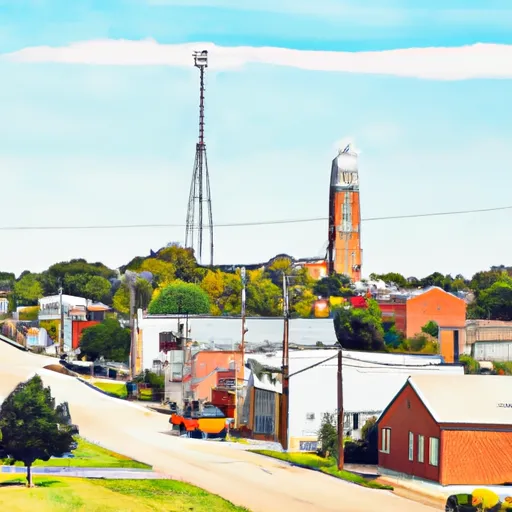-
 Snoflo Premium
Snoflo Premium
Get unlimited access to all our content
With no Ad interruptions! - Start Your Free Trial Login with existing account
Morrisonville
Eden Index
Climate
8.1
•
Recreation
2.5
•
Community
2.7
•
Safeguard
4.8/10

Morrisonville, Illinois is a small town located in Christian County. The town experiences a humid continental climate, characterized by hot summers and cold winters. Average temperatures in the summer range from the mid-80s to low 90s°F (29-33°C), while winter temperatures average in the mid-30s to low 40s°F (2-6°C). Precipitation is evenly distributed throughout the year, with the highest amount of rainfall occurring during the summer months.
Hydrology constituents in Morrisonville are primarily influenced by the South Fork of the Sangamon River, which flows through the town. The river provides opportunities for fishing, boating, and other water-based activities. Anglers can find species such as catfish, bass, and sunfish in the river.
Outdoor recreation opportunities in Morrisonville extend beyond the river, with several parks and natural areas nearby. The nearby Sangamon River Forest Preserve offers opportunities for hiking, camping, and birdwatching, while the Lake Taylorville State Recreation Area is popular for fishing, boating, and swimming. Additionally, there are several golf courses in the region for those interested in the sport. Overall, Morrisonville provides a range of outdoor activities for residents and visitors to enjoy.
What is the Eden Index?
The Snoflo Eden Index serves as a comprehensive rating system for regions, evaluating their desirability through a holistic assessment of climate health, outdoor recreation opportunities, and natural disaster risk, acknowledging the profound impact of these factors on livability and well-being.
Climate Health Indicator (CHI): 8.1
Morrisonville receives approximately
939mm of rain per year,
with humidity levels near 84%
and air temperatures averaging around
12°C.
Morrisonville has a plant hardyness factor of
5, meaning
plants and agriculture in this region thrive during a short period during spring and early summer. Most
plants will die off during the colder winter months.
By considering the ideal temperature range, reliable water supplies, clean air, and stable seasonal rain or snowpacks, the Climate Health Indicator (CHI) underscores the significance of a healthy climate as the foundation for quality living.
A healthy climate is paramount for ensuring a high quality of life and livability in a region, fostering both physical well-being and environmental harmony. This can be characterized by ideal temperatures, reliable access to water supplies, clean air, and consistent seasonal rain or snowpacks.
Weather Forecast
Streamflow Conditions
Lower Illinois
Area Rivers
Lower Illinois
Snowpack Depths
Lower Illinois
Reservoir Storage Capacity
Lower Illinois
Groundwater Levels
Recreational Opportunity Index (ROI): 2.5
The Recreational Opportunity Index (ROI) recognizes the value of outdoor recreational options, such as parks, hiking trails, camping sites, and fishing spots, while acknowledging that climate plays a pivotal role in ensuring the comfort and consistency of these experiences.
Access to outdoor recreational opportunities, encompassing activities such as parks, hiking, camping, and fishing, is crucial for overall well-being, and the climate plays a pivotal role in enabling and enhancing these experiences, ensuring that individuals can engage in nature-based activities comfortably and consistently.
Camping Areas
| Campground | Campsites | Reservations | Toilets | Showers | Elevation |
|---|---|---|---|---|---|
| North Graysport - Grenada Lake | 51 | 279 ft | |||
| Lake Mike Conner | 20 | 314 ft | |||
| Little Black Creek Waterpark | None | 296 ft | |||
| Shockaloe Base Camp I | 10 | 578 ft | |||
| Lake Ross Barnett | 22 | 402 ft | |||
| McLeod Water Park | None | 22 ft | |||
| Big Creek Waterpark | None | 254 ft | |||
| Paul B Johnson State Park | None | 245 ft | |||
| Buccaneer State Park | 276 | 5 ft | |||
| Marathon Lake | 71 | 481 ft |
Nearby Ski Areas
Catastrophe Safeguard Index (CSI):
The Catastrophe Safeguard Index (CSI) recognizes that natural disaster risk, encompassing floods, fires, hurricanes, and tornadoes, can drastically affect safety and the overall appeal of an area.
The level of natural disaster risk in a region significantly affects safety and the overall livability, with climate change amplifying these risks by potentially increasing the frequency and intensity of events like floods, fires, hurricanes, and tornadoes, thereby posing substantial challenges to community resilience and well-being.
Community Resilience Indicator (CRI): 2.7
The Community Resilience Indicator (CRI) recognizes that education, healthcare, and socioeconomics are crucial to the well-being of a region. The CRI acknowledges the profound impact of these elements on residents' overall quality of life. By evaluating educational resources, healthcare accessibility, and economic inclusivity, the index captures the essential aspects that contribute to a thriving community, fostering resident satisfaction, equity, and social cohesion.

